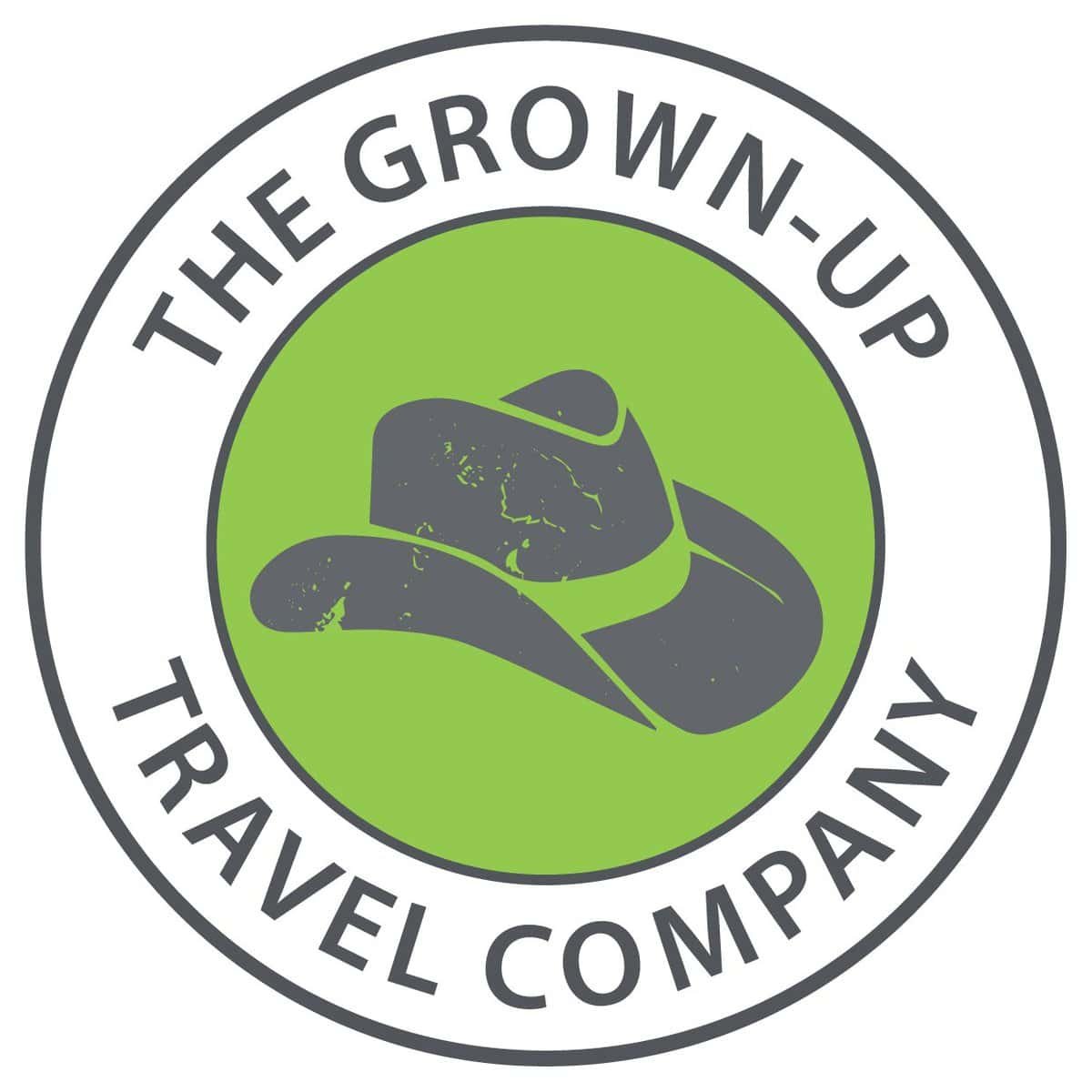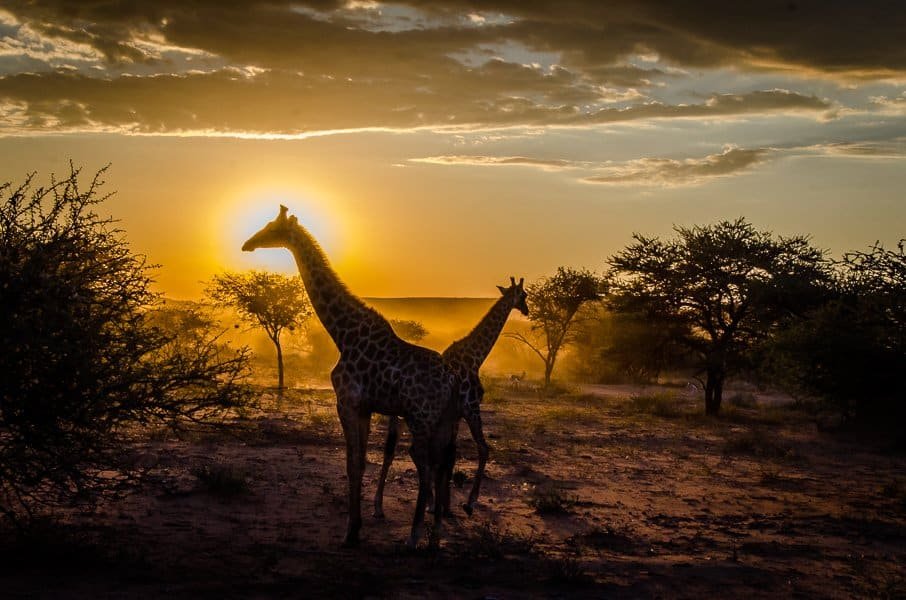This is the first part of the report from my trip to Namibia, you can find part two here: Trip report: Namibia – Driving north to Etosha National Park
Introduction
In May 2019 I attended the Indaba travel trade show in Durban, as I do every year. And as I also do every year, I tagged on a couple of weeks of exploring. I mean I’m hardly going to travel to South Africa for a 3-day show and then fly back to Europe, right? Right.
So on this occasion I had a quick trip to Mozambique first (more on that in a separate article) and then returned to Johannesburg for a night at an airport hotel. The next day I boarded my flight to Windhoek, the capital of Namibia, for my first ever visit to the country.
I’ve been wanting to get to Namibia for several years but had never managed to get things into place. Having known Liz from Wild Dog Safaris for almost as long we had been trying to get the starts to align (and the itinerary in place) so that I could finally experience the country. Wild Dogs run group tours, both accommodated and camping, as well as arrange tailor-made guided trips and self-drive routes for the adventurous. I opted for the latter option, which is the best way to get around this vast country but does involve driving long distances. And by long, I mean long, as you will soon discover.
Liz set up a week-long itinerary taking me north from Windhoek and to Etosha National Park, then southwest down to Swakopmund on the coast before heading south into the edge of the Namib Desert. I would then drive back to Windhoek to drop off the car and fly back to South Africa. And on to Tanzania, but that’s another story…
Namibia in brief
I can’t really beat Wild Dogs’ description of the country, so I won’t bother trying. Here’s what they say: Located in southwestern Africa, Namibia boasts a well-developed infrastructure, some of the best tourist facilities in Africa, and an impressive list of breath-taking natural wonders. Visitors can explore the capital of Windhoek and discover the lovely coastal town of Swakopmund boasting remnants of the country’s German influence, reflected in the architecture, culture, cuisine and the annual Oktoberfest celebrations.
To properly appreciate this extraordinary country, you will have to venture out of the cities to explore the remarkable natural landscapes Namibia has to offer. These include: the impressive Fish River Canyon; the vast Etosha National Park teeming with abundant wildlife, such as lions, desert-adapted elephants and the Hartmann’s Mountain Zebra; the hauntingly beautiful Kalahari Desert; and of course the Namib Desert stretching for over 2000 km along the magnificent Atlantic Coast. Namibia is an ideal destination for travellers seeking an unforgettable African experience in a uniquely beautiful untamed wilderness.
Arrival and hitting the road
I flew from Johannesburg to Windhoek with South African Airways.
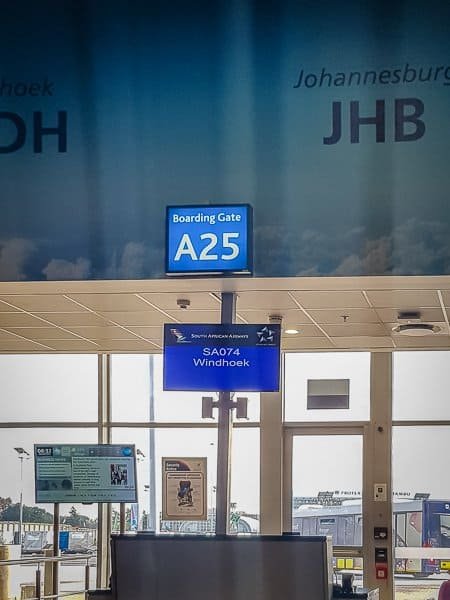
We left on time and the plane was almost full – which is probably not unusual as there are only a couple of flights each day and often only one.
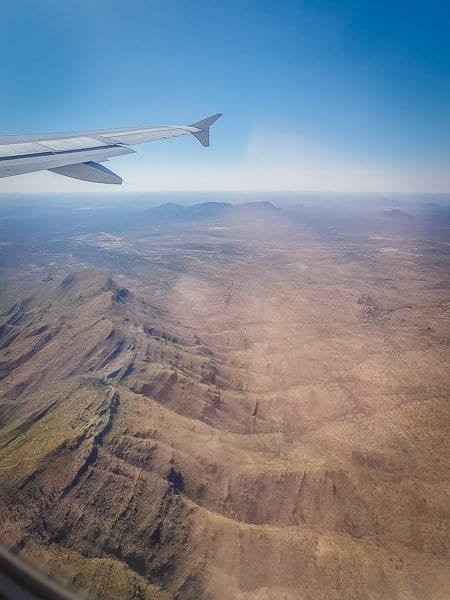
The views from the plane window were spectacular as we crossed into Namibia.

When we landed at Windhoek airport, I got a rapid introduction to the Namibian midday temperature…
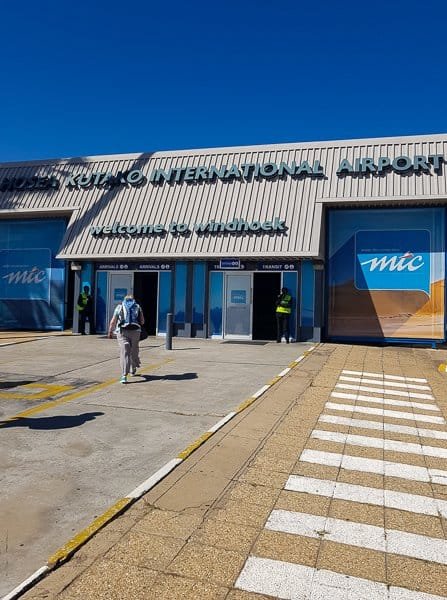
Immigration was quick and easy (UK citizens don’t need a visa, and nor do those of most European countries, the USA and Canada, Australia among others) and my bag arrived without problems. On walking into the arrivals area I soon spotted a guy with a sign with my name on it.
He showed me to his vehicle and we drove into the city, taking about 30 minutes to reach the Namibia Car Rental office to pick up my car.
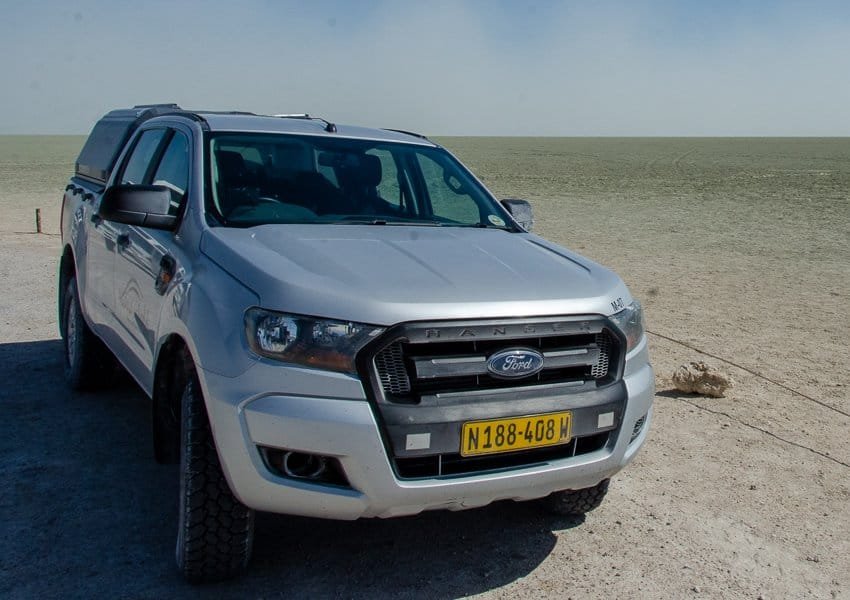
You can drive the route I took in a regular saloon car, but the extra clearance offered by a big beast like the Ford Ranger I was allocated is definitely an advantage. There was also one point I could not have reached on my own without 4WD, but other options were available. If you are planning to drive much further south than I did – or into very remote areas with poor infrastructure – then a 4WD is pretty much essential (and often obligatory).
My car was an automatic – which was nice but not something I would normally pay extra for – and had a double cabin so plenty of storage space, not even including the back of the vehicle.
As with all car rental offices, you’ll need to complete all the relevant paperwork, provide your driving licence and credit card and check over the vehicle to ensure that any damage is inlcuded on the pre-check list.
I opted for “super cover”, which covers you for collision damage waiver, stamp duty fee, tyre and windscreen cover, theft lost waiver, roadside assistance and recovery charges (only if damage not caused by your negligent driving). This is the minimum insurance I would recommend, too. You will have to leave a deposit as a blocked amount of your card – in my case this was N$4500.00. The list of exclusions was long but there was nothing I wasn’t prepared to risk.
It certainly looked like a sturdy set of wheels, and the double fuel tanks would come in handy as distances between petrol stations were likely to be significant.
After a quick briefing about the car itself, a reminder to let air out of the tyres when driving on gravel and sand and inflate them again using the supplied compressor, it was time to get moving.
I would have liked to have had a night in Windhoek so that I could explore the capital, but alas my schedule was far too tight for that and I had just shy of 270 km to my first destination.
The roads were all ashpalt and in excellent condition, meaning that I was able to drive at the speed limit pretty much all the way (usually 120 km/h). It was great to be driving on the right side of the road again (i.e. on the left) too.
Now it has to be said that the landscape on this stretch is pretty boring. It’s essentially flat, consists mostly of huge, fenced farms and there is little of interest on either side of the road.
On the plus side, there a few distractions so you can focus on getting to where you are going as quickly as possible. I can’t pretend I wasn’t disappointed, though – I had expected much more, given the views from the plane and the pictures used in advertising the country. Still, this was just day one…
Okunjima Reserve
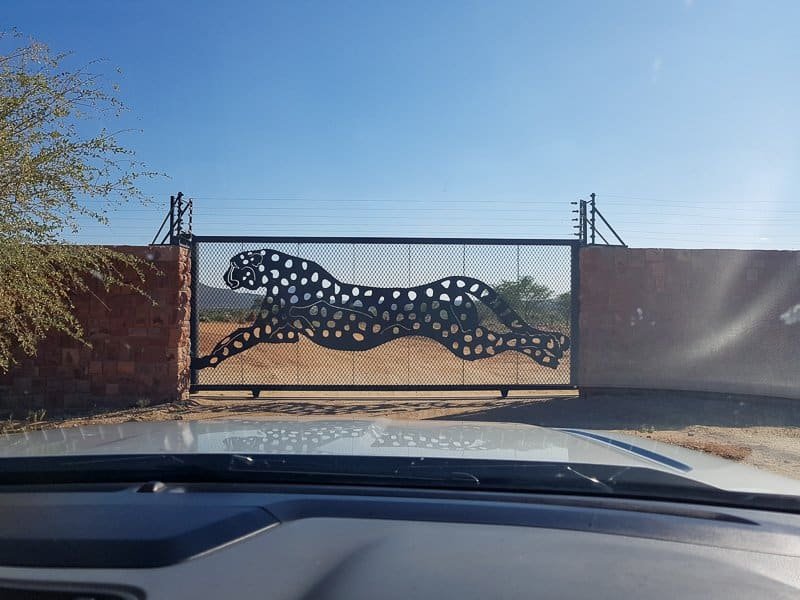
Sited about halfway between Windhoek and Etosha National Park, Okonjima Nature Reserve is a logical place to spend the night or indeed a couple of nights on this stretch of tarmac. It definitely has more to offer than just a bed and a meal as it is home to AfriCAT, a carnivore sanctuary.
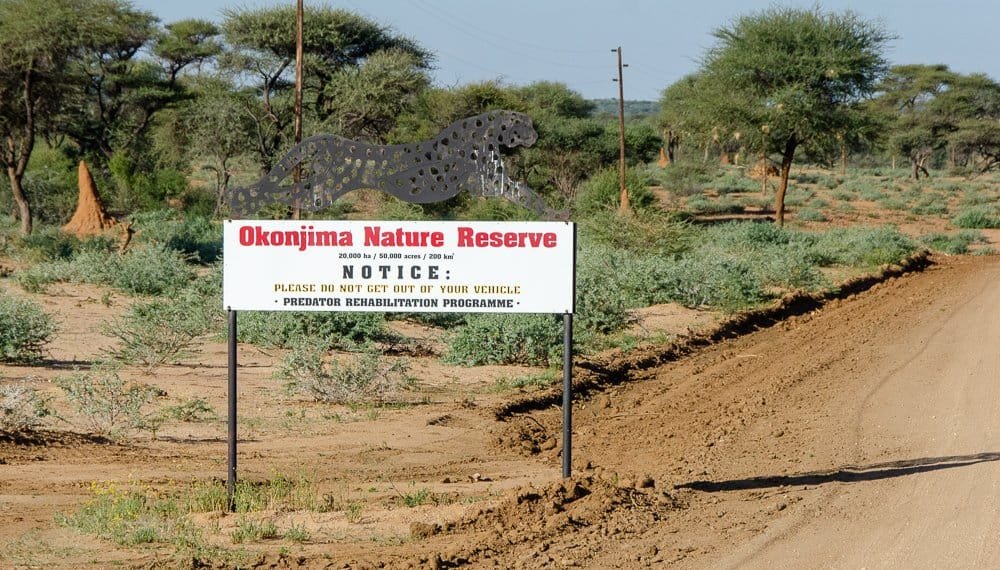
The organisation gives the captive cats a second chance to be released back into the wild and become completely independent hunters in a protected area right in the middle of commercial cattle farmland.
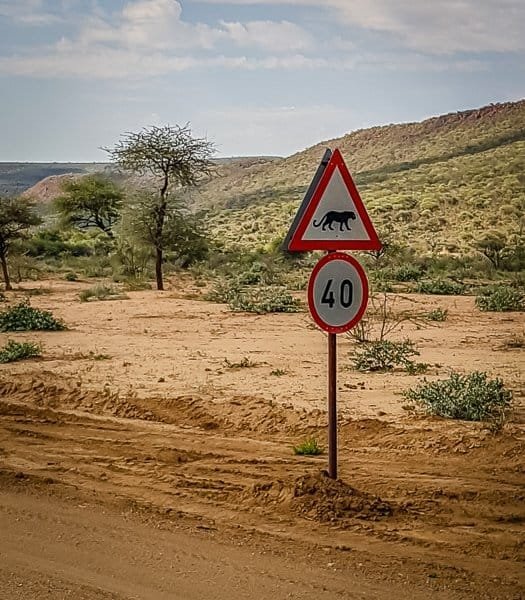
Other activities on offer at Okonjima include cat-tracking on guided safaris, leopard-spotting, off-road night drives and learning about local San culture along the Bushmen trail.
There is also has a range of accommodation options from camping to luxury villas.
Accommodation – Luxury Bush Camp

I was staying at the Luxury Bush Camp, so I followed the signs and arrived at the main building to check in and was impressed by the public areas. There was plenty of space to relax, with a restaurant area at one end and a bar at the other.
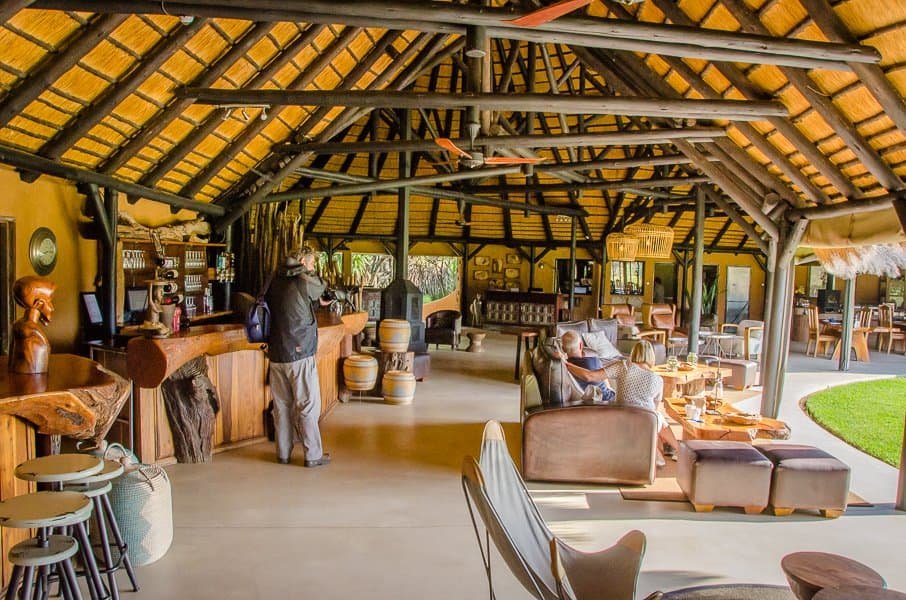
I picked up my key and drove to my villa, where a carport was waiting to shelter my vehicle from the intense Namibian sun.
Here’s a video of my chalet:
A full review of the accommodation will be published on the blog later. In the meantime…
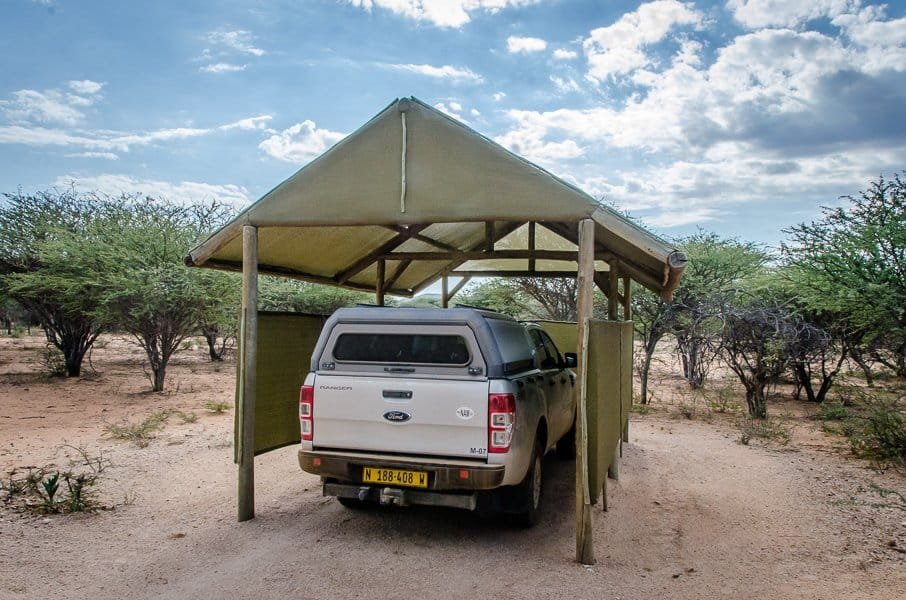
It was then time to check out my digs…
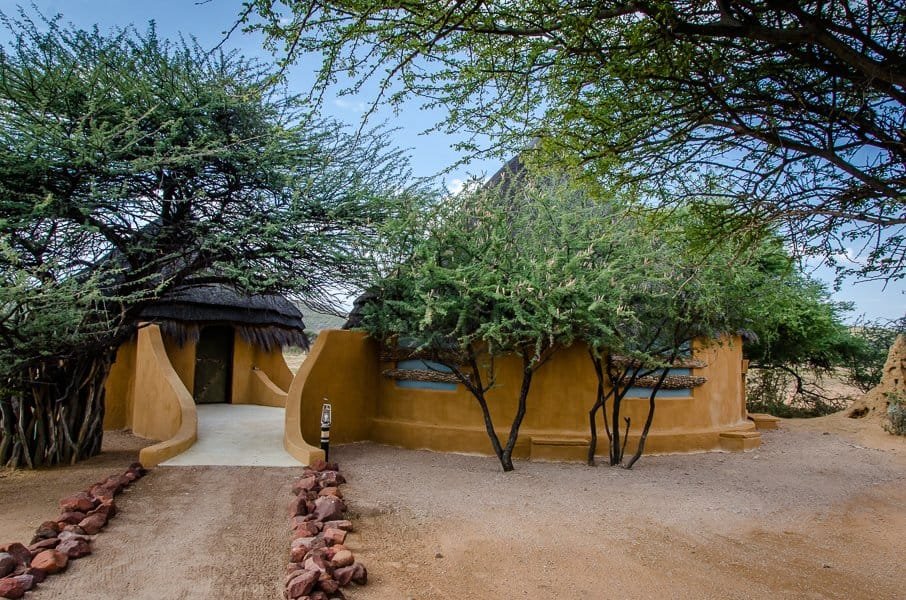
You get a lot of space – the sleeping area is on the right in the photo above and there is a separate lounge building on the left (known as a “sala”).
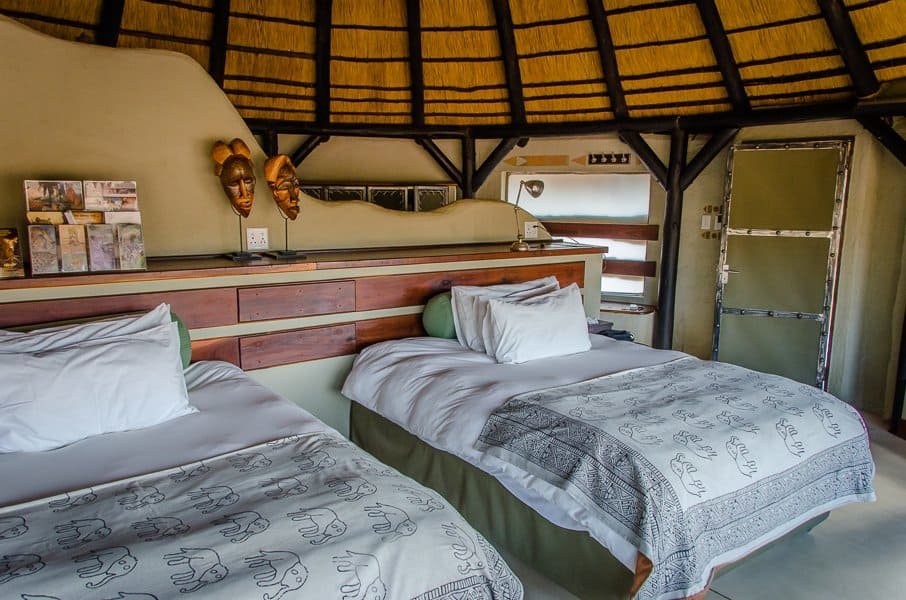
As you can see the bedroom was very spacious, with an ensuite bathroom behind the beds, both of which were huge and comfortable.

You could hardly complain about the view from the bed, either. The villas are set well apart from each other so guests have full privacy.
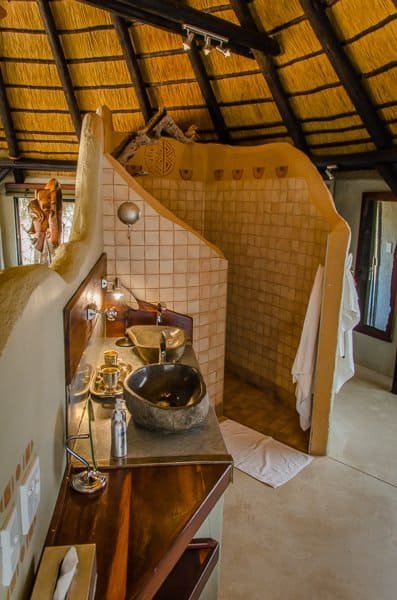
The bathroom section was nicely designed and practical.
Game drive
I had time to join a late afternoon game drive, so after freshening up I was soon clambering aboard an open Land Cruiser. We set off to track some cheetah, who are now living wild on the 22,000 hectare property and are collared, making it easier for rangers to find them. But the system is quite old-fashioned using radio and any obstructions can make it impossible to pick up the signals.

There is a fair amount of other wildlife at Okonjima and we saw quite a lot on the way, but this is not where you come for a real safari experience.

However, I did manage to take one of my favourite photos ever here:

We were trailing a cheetah’s signal for a couple of hours but never found it – and it has to be said the game drive did feel a little artificial, but for a first taste it would certainly be exciting for newcomers to Africa. In the end we did get to see a collared leopard after being tipped off by another driver, but it was too well hidden for a decent picture.

As the sun began to set we headed back for camp.
A little later in the evening I had dinner in the restaurant and the food was wonderful, as was the selection of wines. I slept like a log that night.
After breakfast the next morning it was time to visit the AfriCat centre.
The AfriCat Foundation
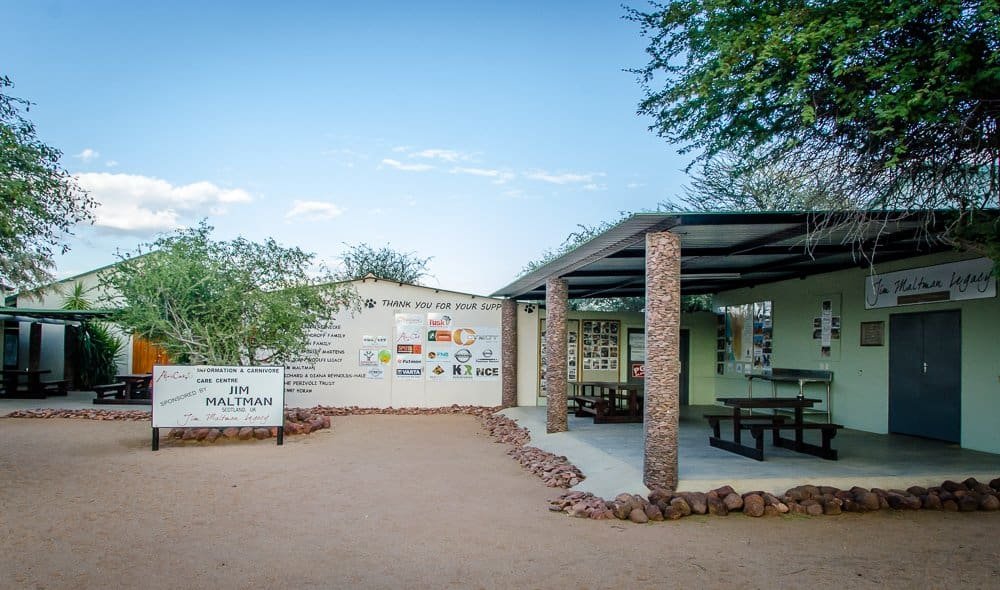
Founded in 1991, the AfriCat Foundation is committed to the long-term conservation and survival of Namibia’s large larnivores in their natural habitat. The Namibia-registered non-profit organisation which started out primarily as a welfare organisation, has since become focused on educating Namibia’s young farmers and school children, communal carnivore conservation, and on research projects which are essential in accomplishing its mission of the long term conservation of Namibia’s large carnivores in their natural habitat.

Its mission is to make a significant contribution to conservation through education.
Being based on the Okonjima Nature Reserve, a private reserve dedicated to conserving wildlife, AfriCat is perfectly situated to conduct ecological research focusing on a variety of rare and endangered species.

Additionally, the captive ambassador large cats allow the foundation to collaborate with international teams of veterinarians to conduct research on various aspects of captive carnivore health, ultimately finding solutions to improve the health and welfare status of captive carnivores throughout the world.

AfriCat’s goal is to create a symbiotic relationship between humans and carnivores to benefit all who live on Namibian land.
Part of the symbiotic relationship is that monies raised through the Okonjima Nature Reserve help to fund the important research, community support programmes and education projects, under the banner of AfriCat.
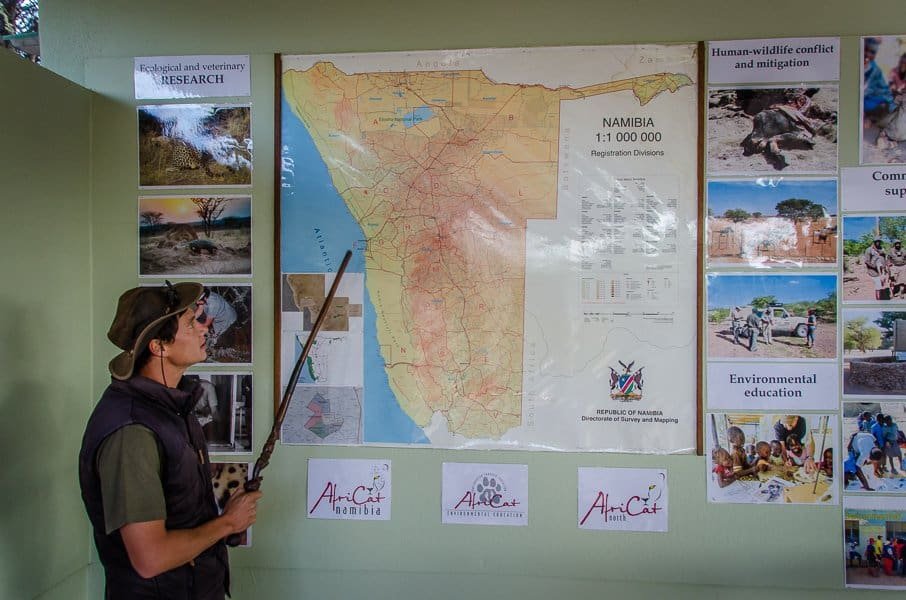
The relationship between the AfriCat Foundation and the Okonjima Nature Reserve is imperative – without education, research and the mitigation of farmer-predator conflict throughout Namibia, the essential conservation of large carnivores would falter … equally, without the partial financial support contributed by the visitors who stay at the Okonjima Nature Reserve, neither would survive.
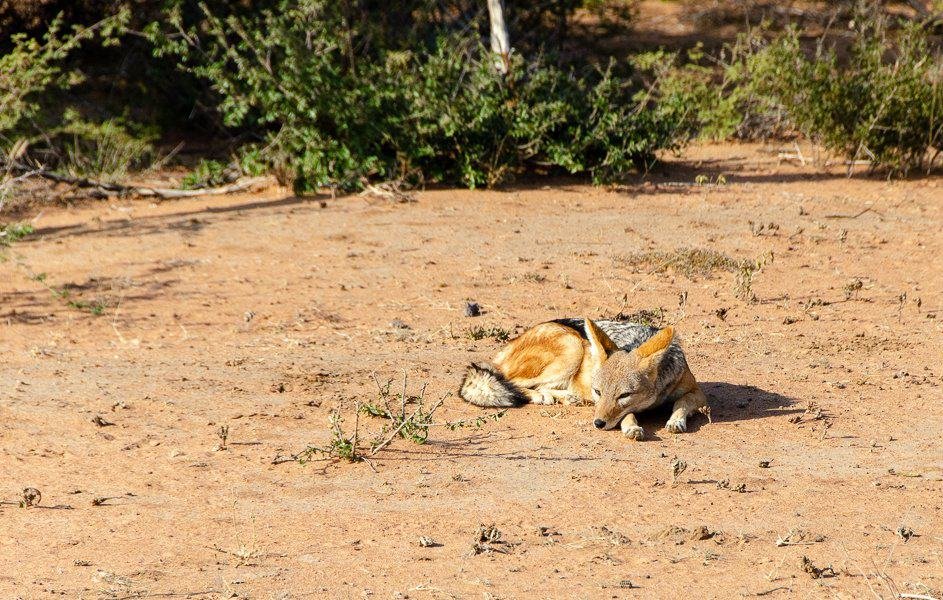
After an educational visit to the centre it was time to go and see the captive cheetahs. We found this sleepy jackal waiting by the vehicle who seemed unfazed by our presence.
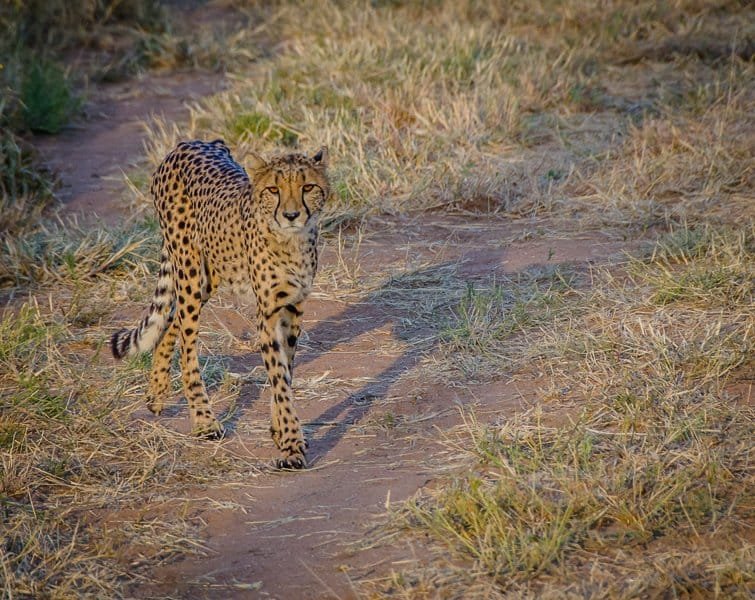
These guys are also used to humans so it is easy to get quite close. I’m no fan of captive wildlife but AfriCat is doing great work and is dependent on captive animals for its research.
And with that, it was time to get back behind the wheel again for my next destination.
Onguma Game Reserve
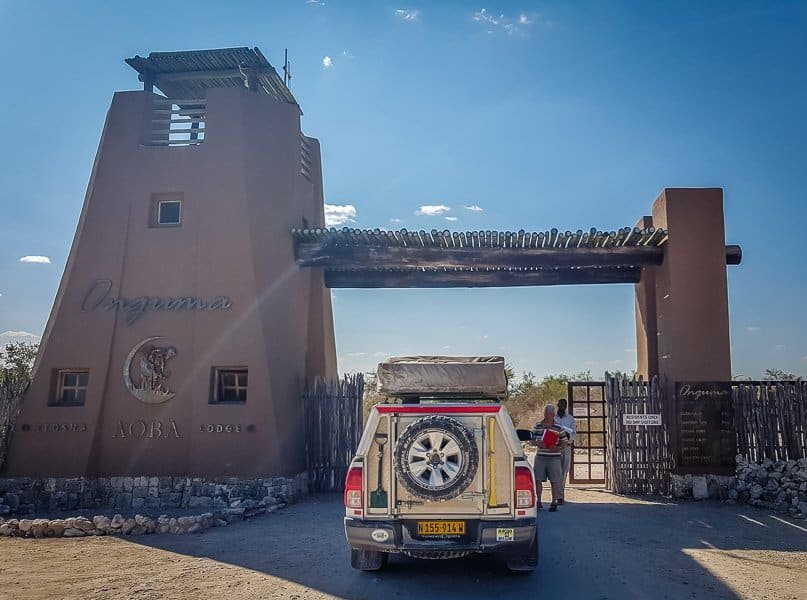
Situated east of Etosha National Park, bordering Fisher’s Pan, Onguma Game Reserve features over 34,000 hectares of protected land scattered with a variety of wildlife including plains game, black rhino, kudu, giraffe, zebra, lion, cheetah, leopard and more than 300 bird species.
The seasonal rains attract thousands of migrating birds to the Fisher’s Pan wetland area. The neighbouring Etosha National Park is home to a rich array of wildlife, including four of the Big 5.
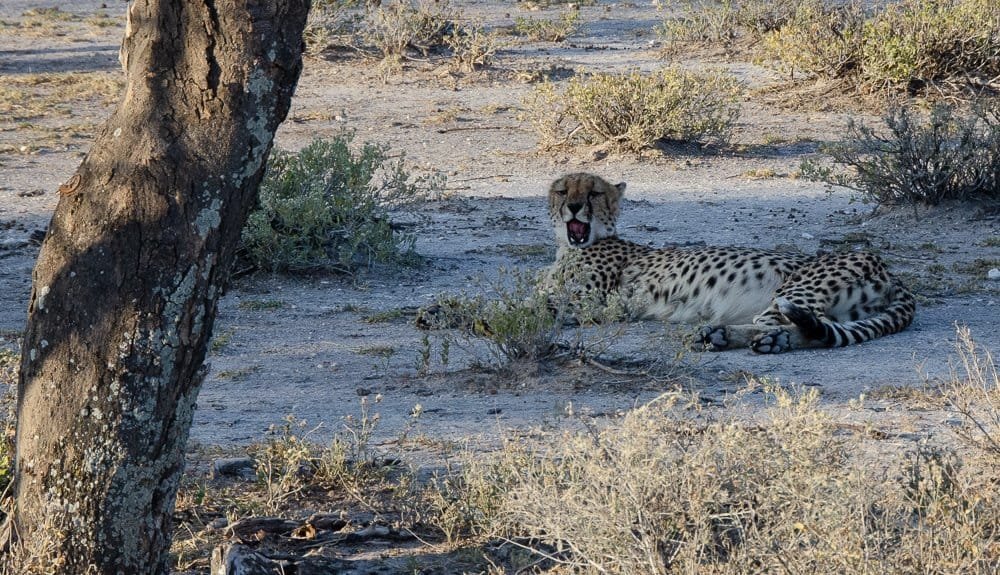
Game drives, guided walks and rhino research drives are on offer within the private reserve as well as wildlife safaris into Etosha to view game in the largest national park in Namibia.
Accommodation – Onguma The Fort
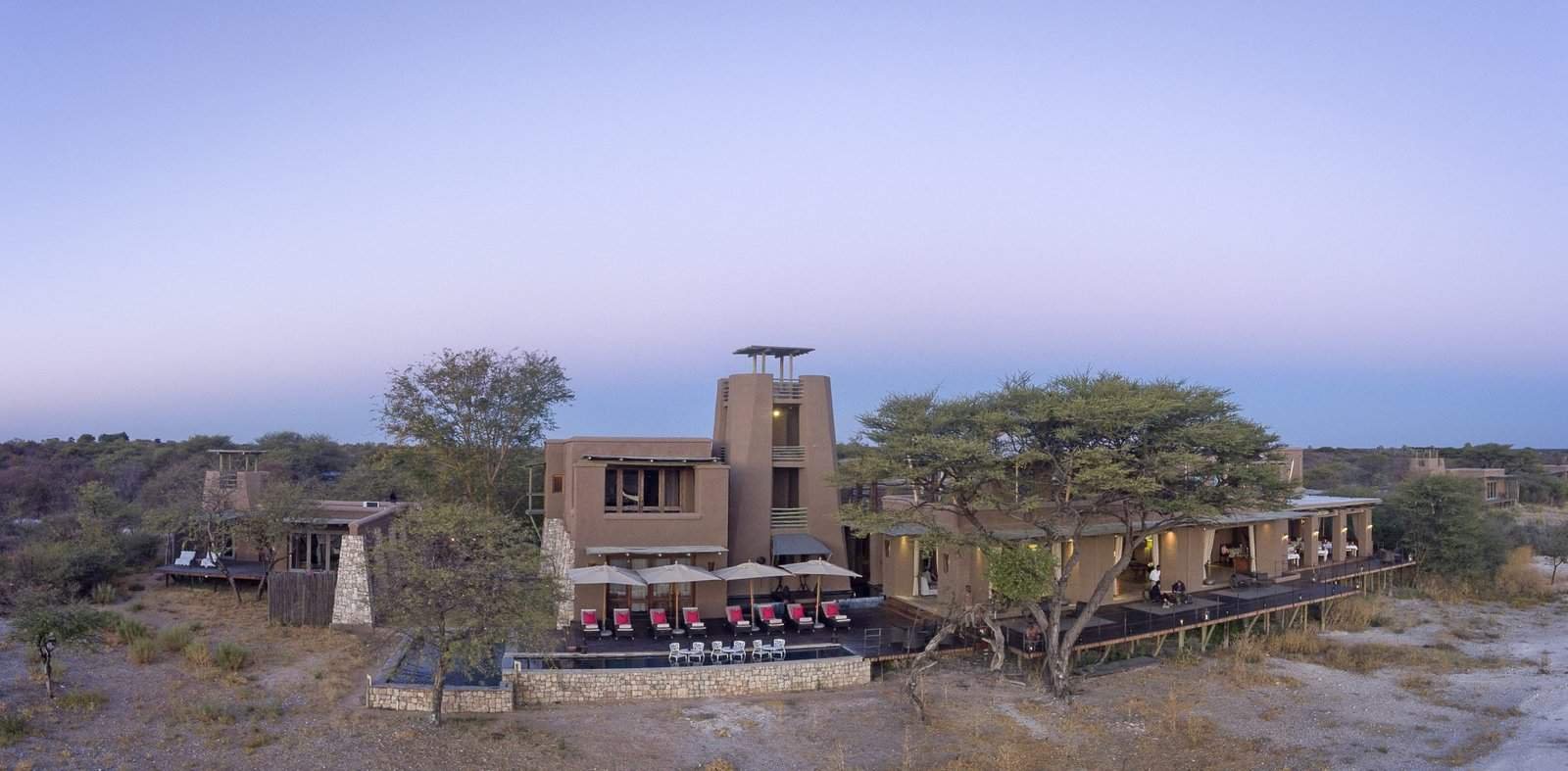
If there’s one thing you expect in Namibia. I’ll bet money on it not being a Moroccan style castle on the edge of Etosha National Park. As the blurb says: “Onguma The Fort is unlike any other.”
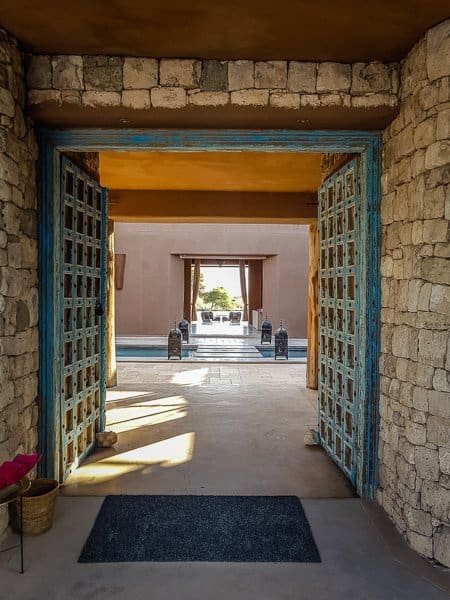
Yet somehow it works, combining an African feel with a touch of Moroccan and Indian flavours, characterised by a selection of beautiful antique windows and doors.
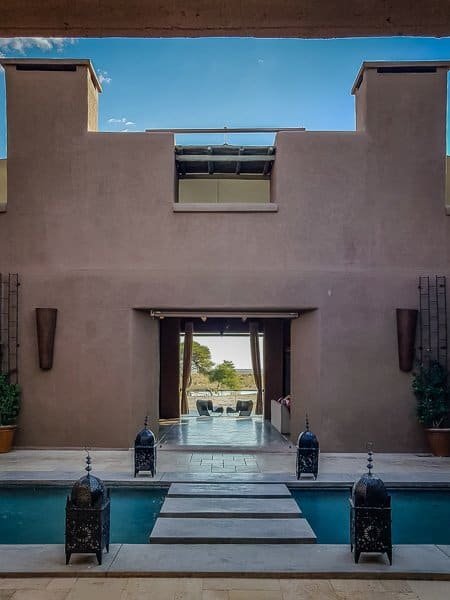
The main entrance provides quite the welcome.
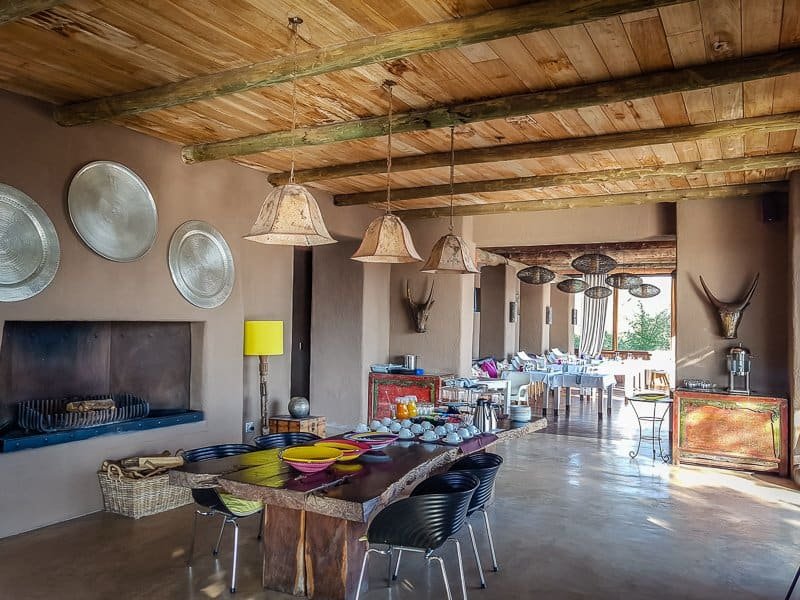
There is a large breakfast and restaurant area, with additional tables outside.
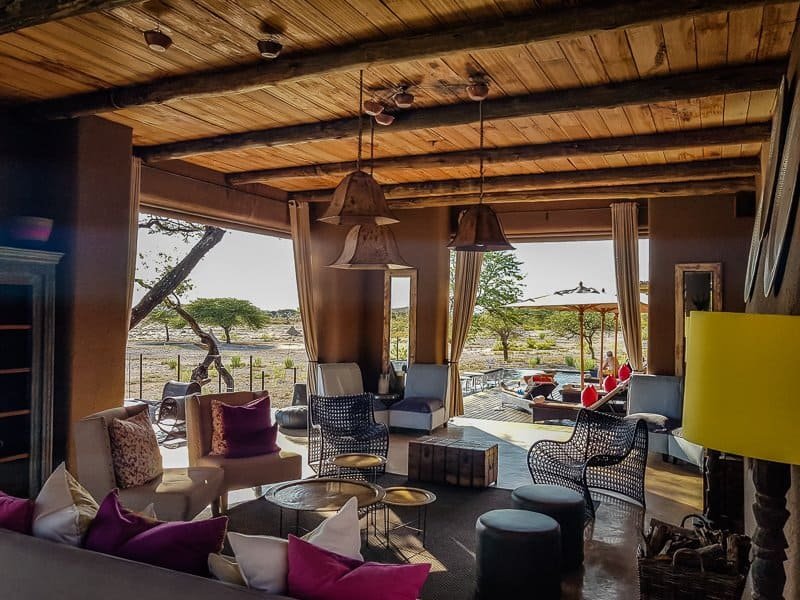
There is also a lovely lounge and outdoor pool.

After checking in I drove to my “room”. Yes, that’s a bit of an understatement…
Here’s a video:
Onguma The Fort consists of 11 Bush Suites (like the one I stayed in) and 1 Honeymoon Suite, all situated adjacent to the Main Fort extending on both sides to the south and the north. Every Bush Suite is completely private and about 50 metres apart from one another.
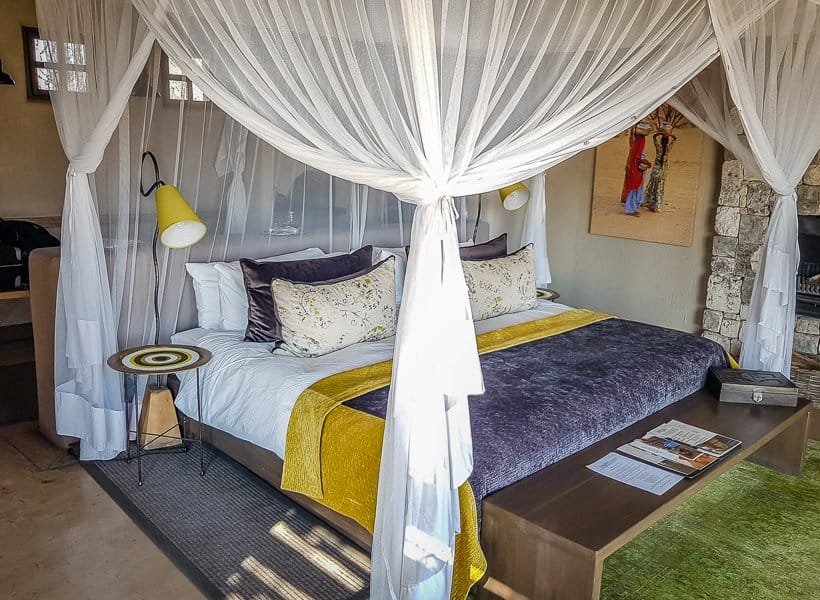
The bed was enormous and I could just as easily have slept crosswise. The bedroom is equipped with both an open fireplace and air conditioning to cover all bases.
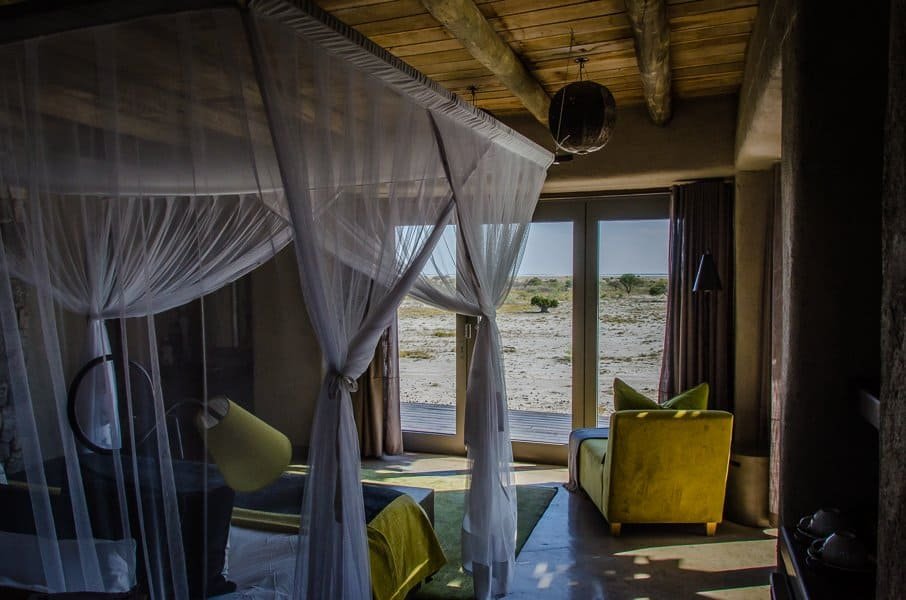
The view from the bed was stunning too, looking towards Etosha National Park in the distance.
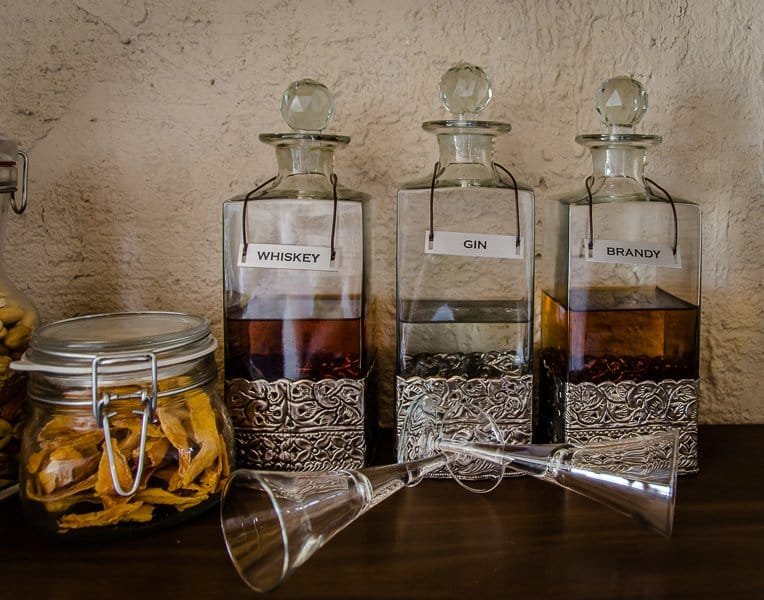
The order of the spirits here brought “Have a drink on me” by AC/DC into my head and it took several hours for it to leave it.
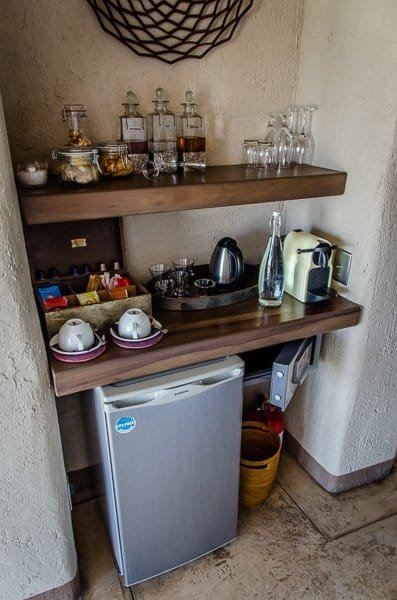
You’ll find coffee and tea making facilities as well as snacks and a fully-stocked fridge. All drinks in the room are complimentary – a fact that I only discovered when I left. This is probably just as well as it would have been easy to go a little nuts after such a long and hot drive.
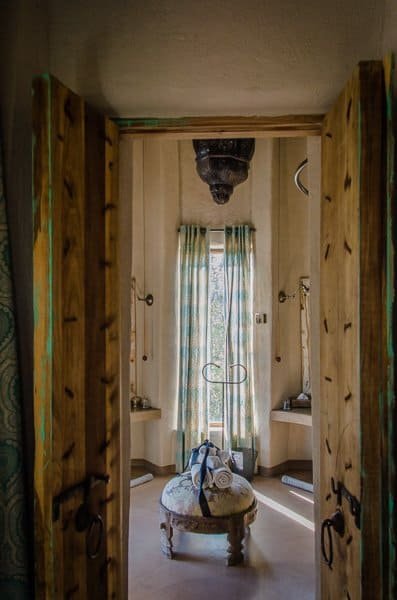
The spacious bathroom has both an inside shower as well as an outside shower area.

It’s beautifully designed, too.
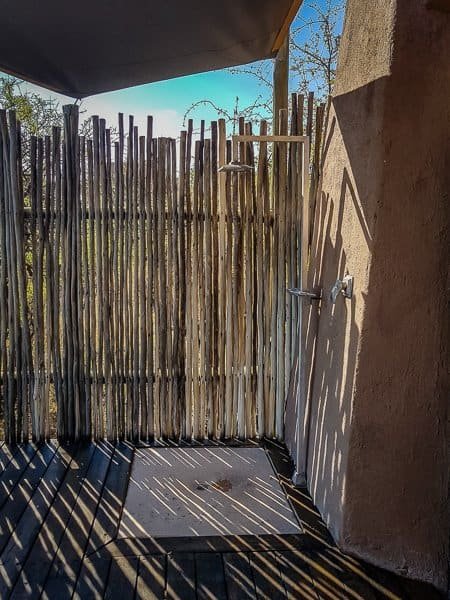
Nothing beats an outdoor shower.
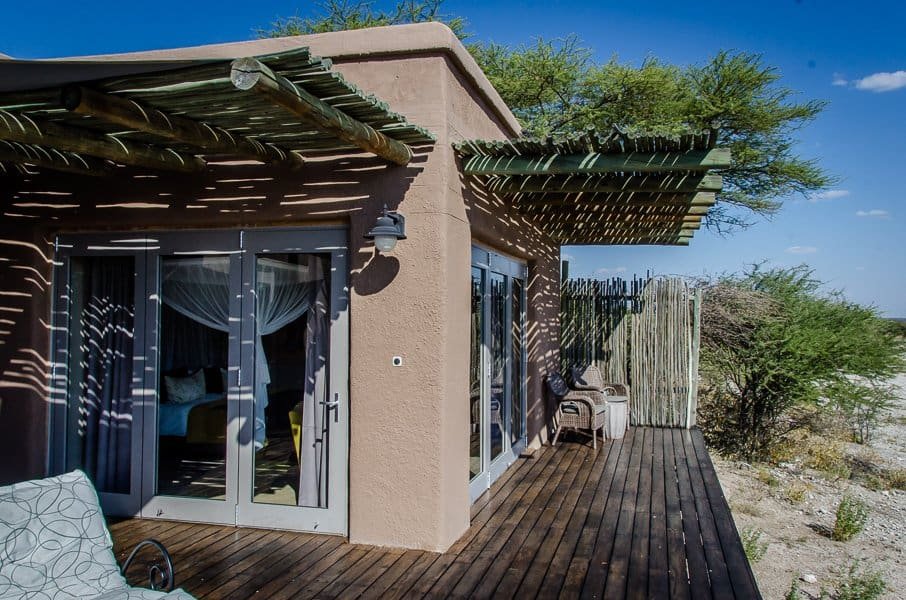
The outside seating area has a couple of sun loungers for relaxing and enjoying the view.
In the evening I went for dinner in the main building.
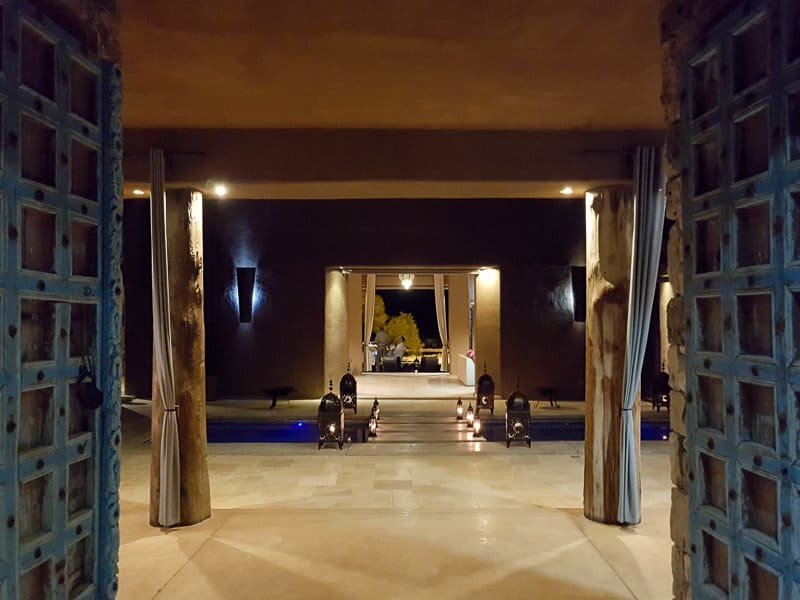
It’s even more attractive at night, too.

The food was absolutely delicious and probably the best I experienced in Namibia. They also have an excellent range of wines and spirits.
I slept so well here and really enjoyed it – I would certainly have loved to spend longer at Onguma The Fort, but I had a full-day game drive across Etosha so I needed an early start.
Etosha National Park
Etosha is one of the oldest game parks in Africa and Namibia’s number-one tourist destination. HIt is home to 114 large and small mammal species, more than 400 recorded bird species, scores of reptiles and even a fish species. The size of the park has been reduced considerably since it was first proclaimed in 1907, but it still remains larger than several European countries.
The Ondonga name for the pan was Etotha, meaning ‘the place where no plants grow’, but early European traders, unable to pronounce the name, called it ‘Etosha’. The pan was once part of the massive Lake Kunene fed by the Kunene River, which at some time in the distant past dried up, leaving the current pan system. Newly excavated fossils belonging to marsh-dwelling antelopes such as sitatunga, lechwe and tsessebe, and a 90-cm long catfish, are testament to much wetter periods.
Etosha has a proud record of black-rhino conservation, and white rhino were recently re-introduced. The park has also played a major role in the recovery of the endemic blackfaced impala.
It is also very popular with self-drive visitors, given that most of the trails are asphalt, meaning that you don’t even need a 4WD vehicle. In my opinion, this is more of a disadvantage than a benefit, as traffic volume is much higher and many drivers do not really know how to act around animals. But I was a self-driver myself this time, so I was keen to see how the experience held up against guided safaris elsewhere.
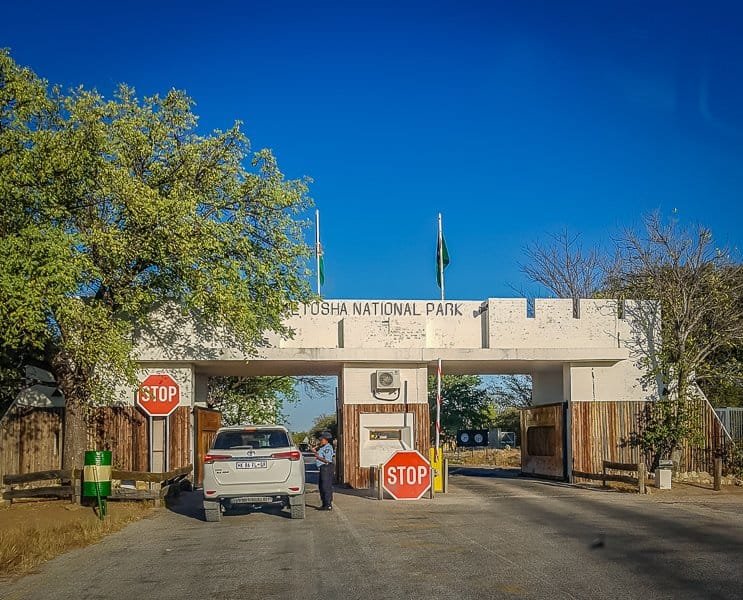
I got to the gate just after it opened (sunrise) and headed into the park. I didn’t have to wait long before my first sighting.
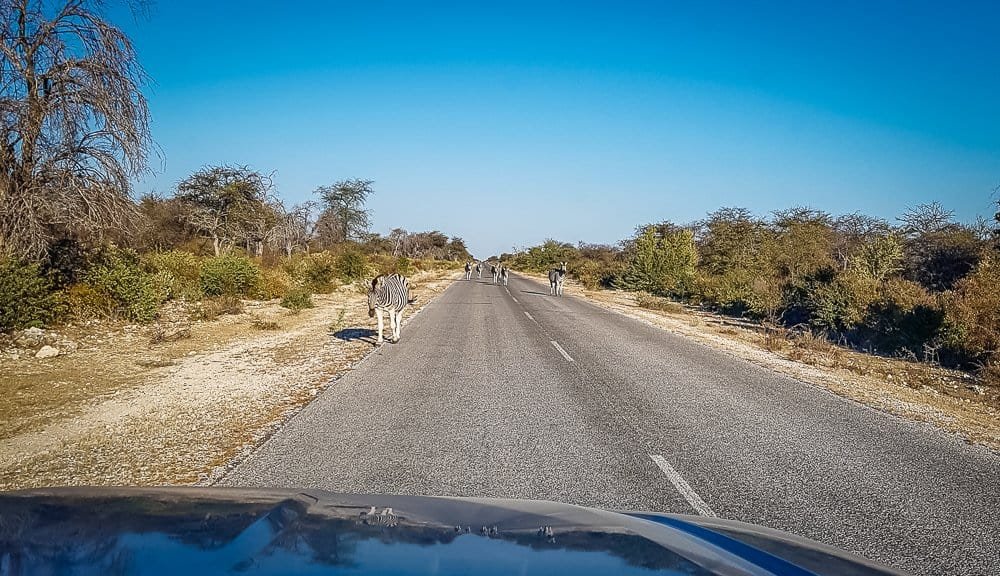
These guys seemed pretty unphased by the cars on the road, and were probably very used to passing vehicles.
I wanted to get off the main road through the park which was already crawling with traffic and headed south onto one of the many “loops” to a waterhole.
In the dry season, which is when I visited, the trick is apparently to wait by the waterholes for animals to come to drink. At this one however, a huge group of zebra was there already…
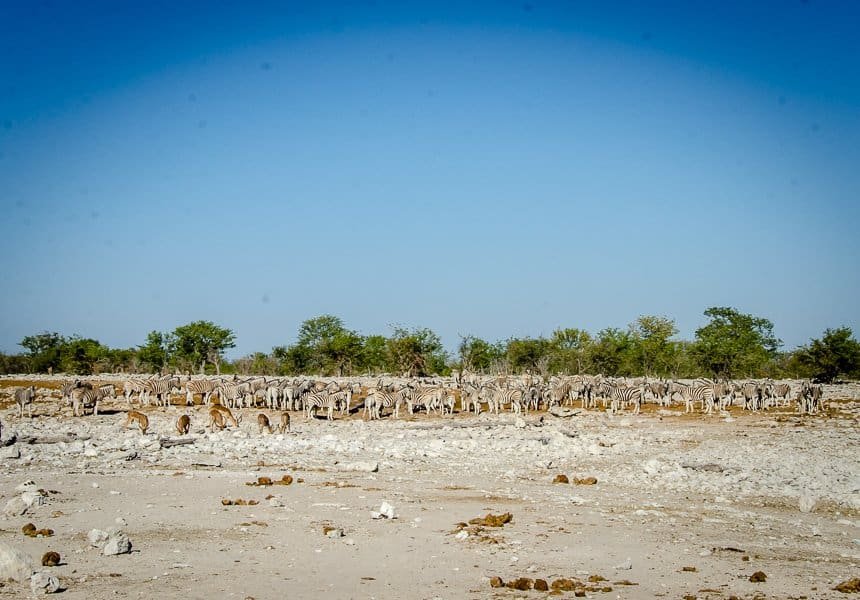
That was the biggest herd I have ever seen in one place, so that was a good start.
I continued on the loop to return to the main road and en route I noticed something in the middle of the track ahead.
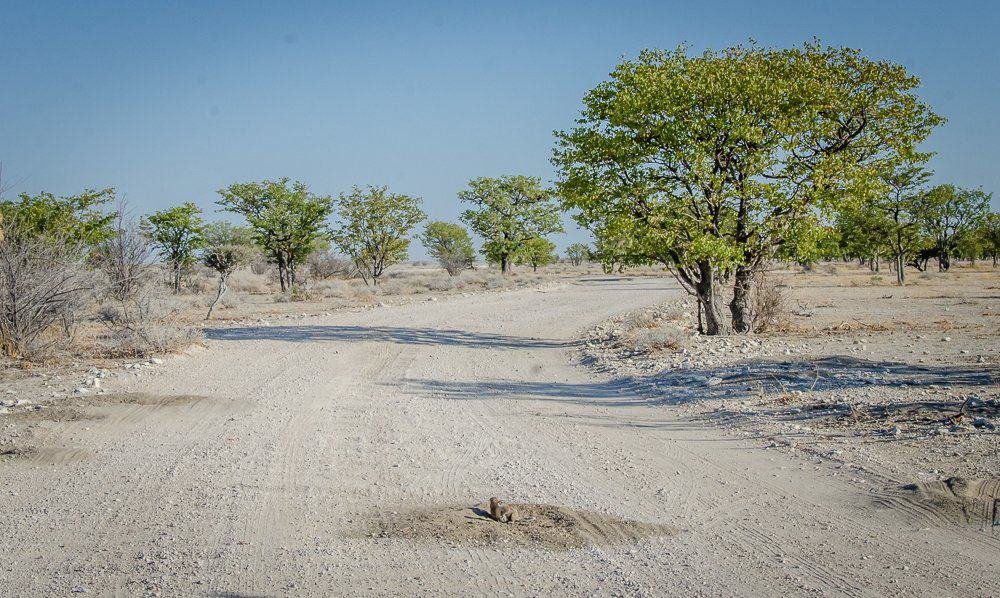
Yes, it was a squirrel, who had basically picked the worst possible place to build a burrow.
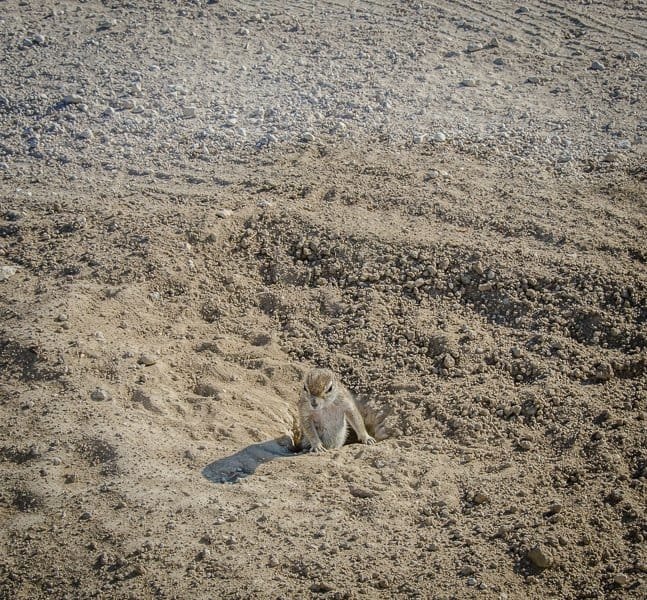
And he showed no sign of wanting to move, so I carefully drove around his home.
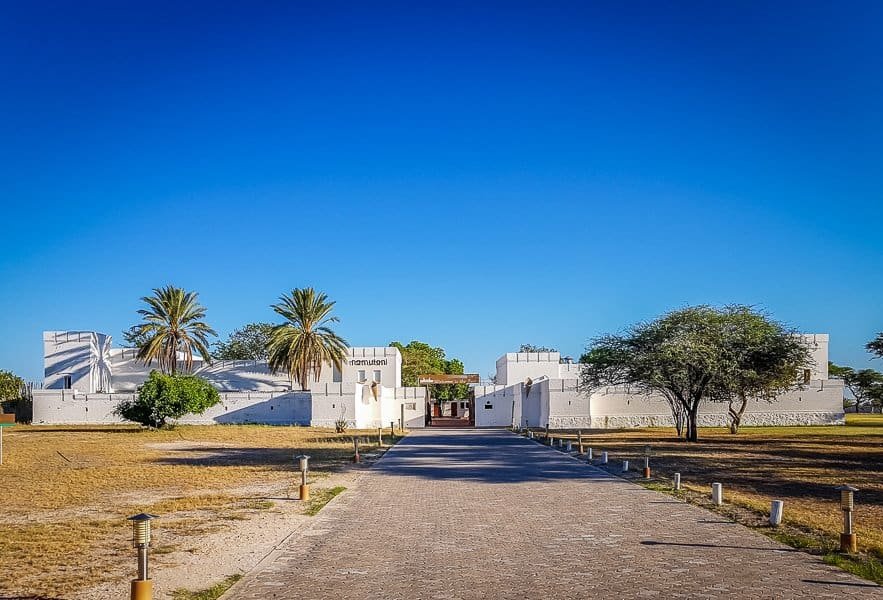
I had to make a brief stop at Namutoni Camp to pay my park fees. Back on the road again, I soon saw some giraffe on my left.
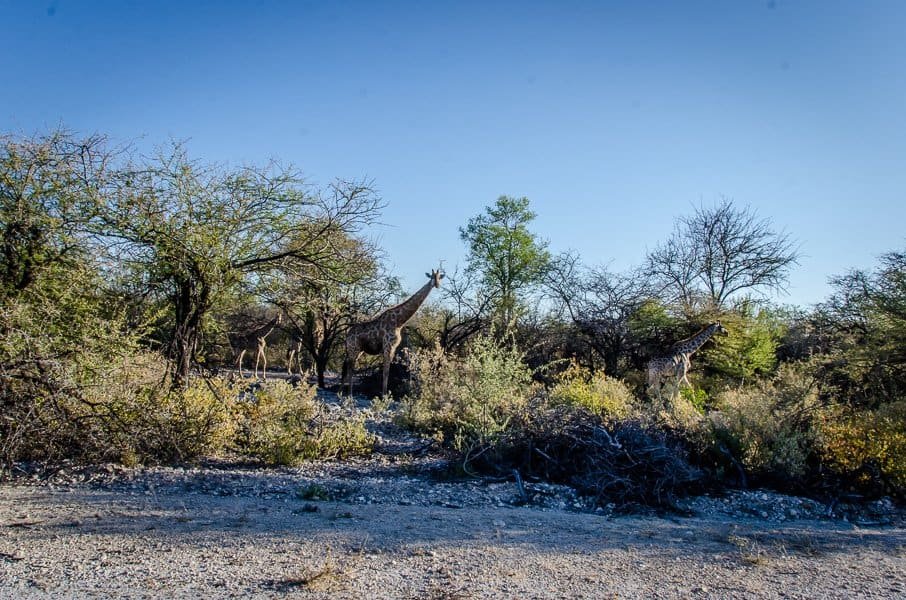
Unfortunately, this is about as good as it got for me in Etosha. I drove for several hours without seeing any wildlife apart from zebra, giraffe and a few elephants in the very far distance.
The landscape is amazing though, and I had to drive to the viewpoint across the mind-blowingly huge Etosha Pan.

By this time the heat was seriously intense – make sure your vehicle has air conditioning…
I then drove on to Halali Camp, which is about half way from Onguma to my accommodation for the night and a VERY popular place to stop for lunch (or stay overnight).
The restaurant has a self-service buffet which unfortunately was rather poor, especially compared to the food I had been enjoying so far in Namibia. But they have a captive, hungry audience and know they can get away with basic catering I suppose.
I was then on my way again, and once again I had a very unproductive game drive. Okay, I did see a lion but it was so far away that even with binoculars it was difficult to view it properly.
I decided to call it a day about 1530 as I arrived at Okaukuejo, hoping that I might get lucky at the waterhole there at sunset.
Okaukuejo Resort
This formerly government-own camp is located 17 km from the southern entrance of the park, and famous for its flood-lit waterhole. It’s a large, sprawling resort with a range of accommodation from campsites to chalets and is a good value place to stay in the park.
It has a restaurant, bar and swimming pool too so is a nice place to relax. It also has a petrol station, which is useful for drivers.
Accommodation
I stayed in a bush chalet, and here’s a video it here:
Here’s a few pictures from the inside:

The bedroom was spacious, clean and had air-conditioning.
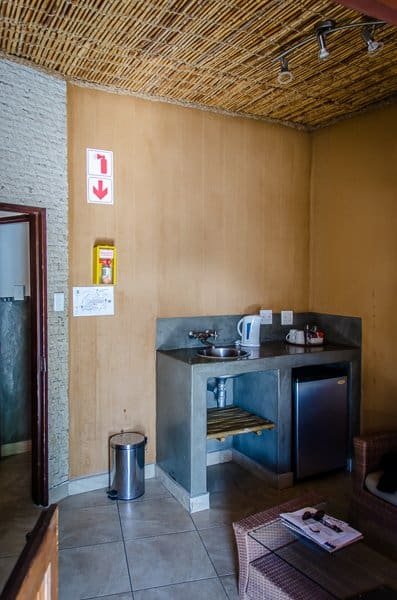
A small kitchen area is also provided. There is no stove but of course there is a brai area outside.

The bathroom was also on the small side but the shower worked well.
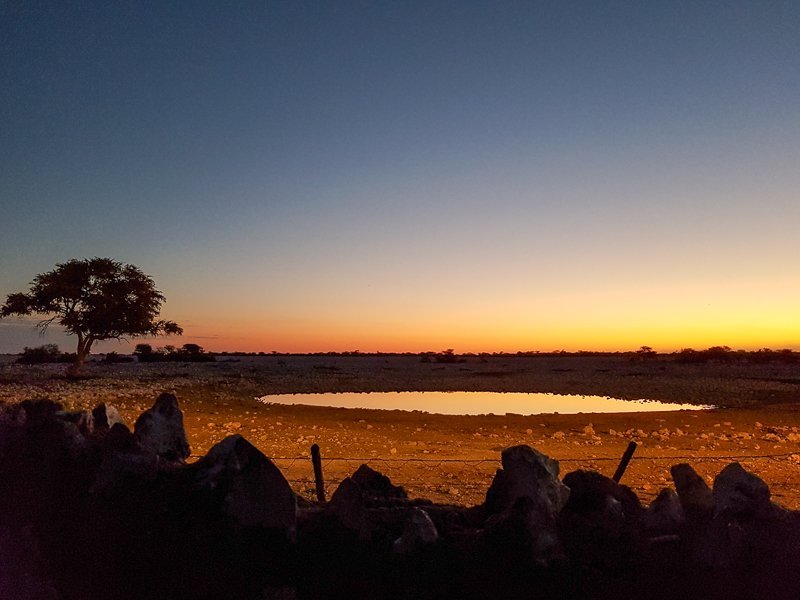
Before dinner I joined the throng of guests gathering by the waterhole. It was beautiful as the sun set, but once again the wildlife was hiding.
I can only assume this is fate telling me I need to return to Etosha National Park and spend longer here…
I hope part one of this trip report this has made you want to visit Namibia. If so, contact me to chat or to arrange your dream trip. For an example self-drive tour following the same route as described in this report, click here.
You can continue reading about my trip in part two of the report here: Trip report: Namibia – Driving north to Etosha National Park
